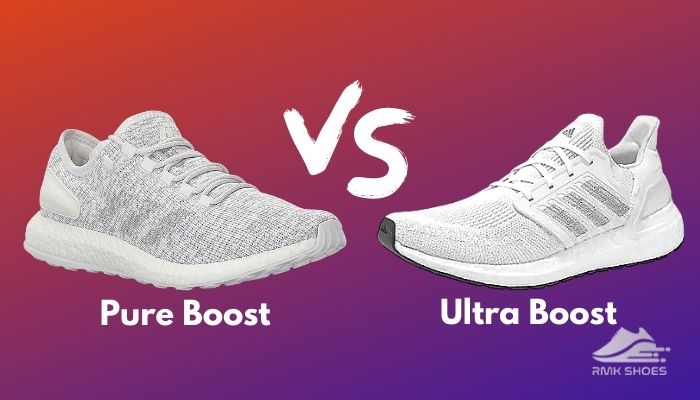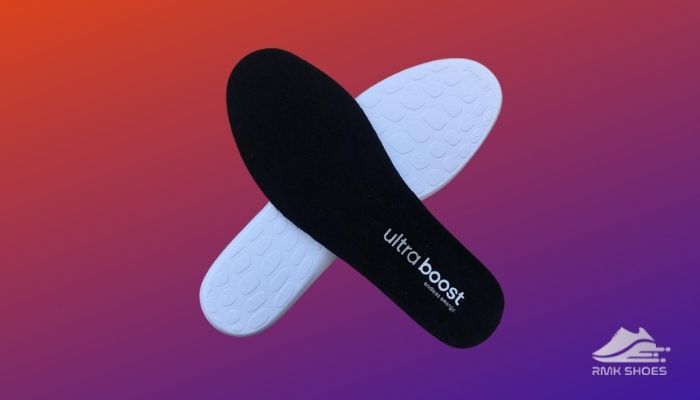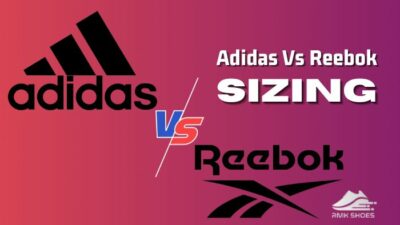When you talk about Boost sneakers, the Pure Boost, and Ultra Boost are the OGs. With them in the front line, Adidas has shelled out hot sellers, one after another.
What’s the primary difference between Pure Boost and the Ultra Boost?

Pure Boost Vs Ultra Boost- Background
Back in 2007 the German chemical company BASF wowed Adidas with their innovative foam material. Immediately Adidas saw the potential and started brainstorming for ideas. After six years of thorough research and a fierce determination to revolutionize the running industry, Adidas dropped the Energy Boost in 2013.
Some running publications had their fair share of reservations but the Energy Boost was received positively by the mass crowd. Upon the positive debut the sportswear giant didn’t stop, they kept on pushing their boundaries in pursuit of better results.
Still, behind rivals, Nike, Adidas On May 14th, 2014 Adidas launched the Pure Boost. In every way, it was an upgrade from its predecessor. It sported a full-length Boost midsole and excellent impact protection. All in one, it was a success.
Adidas did not stop there! The research continued for the game-changing running shoe. In 2015 the sportswear giant released the Ultra Boost. It was a hit. The intense research finally paid off. Not only it became Adidas’s flagship running shoe, but it also cemented its place among athleisure enthusiasts which was quite the trend at the time.
Related content you should read Adidas vs. Nike Sizing
All You Should Know About The Pure Boost-1
After successfully implementing Boost technology into running footwear, Adidas debuted the Pure Boost in Spring 2014. It was the first time Adidas brought the much-coveted Boost midsole to casual footwear.
Following the success of the ZX Flux, the Pure Boost became extremely popular due to its lightweight, minimal design, and incredible comfort.
The black colorway along with the grey infrared and solar blue was released on May 14th, 2014 for a retail price of $120.
On the lateral side light knit composes the lightweight upper which is overlaid with molded plastic to provide structure. Suede composes the heel on top of a boost sole. The medial side is symmetrical to the lateral side.
At the back of the shoe, Black suede wraps around the heel and features Adidas branding in premium plastic on top of the Boost sole.
At the top, the light knit upper’s overlaid with molded plastic that composes the eyelids that hold black flat laces that run over a black suede tongue. There’s no insole, instead, thin inner linings are overlaid on top of the Boost cushioning.
The standard Pure Boost outsole’s composed of grey rubber in a web pattern applied directly to the bottom of the Boost cushioning with a hit of black rubber under the heel.
Years after its initial debut, the Pure Boost is still incredibly popular inspiring new casual silhouettes from Y3 to forming the foundation of the Adidas Yeezy footwear line and receiving follow-ups with further iterations.
You may also like to read: Adidas Shoes Fitting Guide
Ultra Boost 1.0- The Game Changer
Adidas released the Ultra Boost in an interesting time. It was 2015, sportswear and high fashion were quite the chorus. Immediately smelling an opportunity the three-stripe brand embraces the streetwear culture and releases the Ultra Boost.
The front half of the upper of the shoe is made up of primeknit, it’s a super soft knit and feels like a pair of socks on your feet. On the toe of the shoe is the arrow primeknit pattern which gives it a distinct aesthetic. Ventilation holes of the knit come together to create this pattern which points forward.
As you move up on the shoe, you get the flat laces. On top of the soft tongue, you get a textile mesh material (which is super soft) with the Adidas logo on a small tab in the center.
Moving inside the shoe you get a super comfortable sock liner which is heavily padded. Rounding the inside, you get an insole with Ultra Boost printed on it.
Adidas uses a type of textile mesh around the midfoot and heel of the shoe, as a reason, there’s less space around the heel and the ankle that results in a relatively tight fit. Nonetheless, the shoe fits true to size. There’s also a pull tab which makes wearing the shoe a whole lot easier.
You also get the trademark midfoot cage for extra support. Moving further back you get the very supportive Ultra Boost heel counter.
Finally, moving to the bottom of the sneaker you get the black continental rubber outsole with the Torsion system technology in the midfoot.
PS: The very first Ultra Boost 1.0 didn’t feature the continental rubber outsole. Upon seeing the low durability of the regular outsoles, Adidas made them a standard for the later versions. You’ll be happy to know, the Ultra Boost 1.0 available today comes with the durable continental rubber outsole.
Also, follow our epic guide to know Red Wing Boots vs. Georgia Boots: Which Is The Best For You?
Pure Boost Vs Ultra Boost- Key Differences
Clearly, there are differences between the Pure Boost and Ultra Boost. Some are clearly visible while others are not. For your convenience, I’ve compiled the noteworthy differences between the two silhouettes.
Here are key differences between the Pure Boost and the Ultra Boost:
The Upper
The Pure Boost sports a durable Light Knit upper. On the other hand, the Ultra Boost features a super soft and stretchy Primeknit upper.
The Insole

The Pure Boost doesn’t feature an insole instead, you get thin inner linings overlaid on top of the Boost cushioning. However, you do get an insole in the Ultra Boost. It features an Ultra Boost imprint on it.
Follow our guide to know Red Wing VS Caterpillar: Who Makes The Best Boots
The Outsole
The Pure Boost comes with a web patterned outsole that consists of rubber. In contrast, the Ultra Boost features the Continental Rubber Outsole which provides 30% more traction than other outsoles.
Cushioning
The Pure Boost gives responsive cushioning and ensures proper shock absorption. The Ultra Boost offers cushioning in the forefoot area but it’s firmer in the midsole in contrast to that of the Pure Boost.
Flexibility
The Primeknit on the Ultra Boost is more flexible and durable compared to that of the Lightknit of the Pure Boost.
Breathability
The Primeknit on the Ultra Boost has ventilation holes that allow your feet to breathe during your daily stride. The Lightknit also offers decent breathability due to the material being relatively thin. But the Primeknit with the ventilation holes gets the edge.
Fit

The overall construction of the sneakers plays a big role here. The Ultra Boost with the midfoot cage with the aligned heel counter makes the fitting relatively tighter to that of the Pure Boost.
Also, read Dansko Vs Crocs: Who Is The Winner
Overall Support
Ultra Boost provides more containment around the midfoot when you tie your shoes. You get padding all around the shoe and the toe guard area. The cherry on the cake is the molded heel counter which provides you a natural fit and proper stability.
The Pure Boost doesn’t feature the midfoot cage nor the molded heel counter. You get a suede inspired heel counter which offers decent support and stability but it tends to take away some degree of comfort.
Durability
The Primeknit technology used on the Ultra Boost makes them a little bit durable than the Pure Boost. As for the outsoles, the continental rubber used on the Ultra Boost has a longer lifespan than the rubber compound used on the Pure Boost.
What Makes The Boost So Special?
The Boost technology is a result of the Adidas Innovative Team (AIT) and German chemical company BASF. The contradictory topic of soft and responsive cushioning was finally a thing of the past.
At the time, EVA foam was the industry standard for performance running shoes but the Boost technology set a new benchmark. With the Boost midsole, you get soft cushioning with excellent responsiveness.
Another benefit you get is that the Boost offers a great degree of energy return. What’s energy return? Well, it’s more of a marketing term. In reality, it donates the energy that the shoe retains when force is exerted on it by a runner’s stride.
Adidas claims the Boost midsoles return more energy than they gain making your runs more effortless.
Pure Boost Vs Ultra Boost- Further Iterations
The OG Pure Boost and Ultra Boost 1.0 are the foundations of the Boost line of sneakers from Adidas. Their introduction revolutionized the running industry forever and left Nike biting the dust. Kudos to Adidas for their monumental effort.
As we all know the Germain giant always had this knack for improving from their previous models. Well, you won’t be surprised to know Adidas has released further iterations of both the Pure Boost and the Ultra Boost. Let’s have a look.
Pure Boost – Later Versions
After launching the first Pure Boost Adidas now has four other versions of it in their plethora of running shoes.
Here are the other versions from the Pure Boost-1
Pure Boost-2
The second in the line of Pure Boosts hit the market rather silently. It has the similar Light Knit in the forefoot but has this suede inspired material in the midfoot for better support. Plus it comes with a pull tab which makes fitting in your shoes much easier.
Pure Boost-2017
Released in February 2017 it’s a whole lot different from its predecessors. The previous models were more of lifestyle based silhouettes but this one’s more of a performance running silhouette.
The upper consists of circular knit which is a bit sturdier compared to Primeknit. The big difference this one has from its predecessor is the burrito tongue. It’s designed to fit every single individual’s feet.
It also gets a better heel counter than its predecessors. Adidas has given it an extra lace loop in case you need more lockdown.
Pure Boost DPR
The Pure Boost DPR was the second Pure Boost model to be released in 2017 right after the Pure Boost-2017. DPR stands for Deconstructed Pure Racer. It comes with the same kind of heel pads as the Pure Boost-2017 but does not feature the burrito tongue.
The stretched web outsole isn’t as good as the continental rubber outsole but it does provide decent traction. The aesthetics of this shoe is brilliant though.
Pure Boost Go
The latest in the line of Pure Boost is the Pure Boost Go. This is the only Pure Boost model that comes close to an Ultra Boost.
Ultra Boost- All the Versions
Ultra Boost 2.0
Ultra Boost 3.0
Ultra Boost 4.0
Frequently Asked Questions
Is the Pure Boost better than Ultra Boost?
It depends on the purpose you want to use the sneaker. As a running shoe, the Ultra Boost edges the Pure Boost. But as a lifestyle sneaker, the Pure Boost should be your go-to.
What’s the most comfortable Ultra Boost?
The Ultra Boost-19 is deemed by many as the most comfortable Ultra Boost. It beats out the Ultra Boost 1.0 in every aspect in terms of performance. Plus the price on both shoes is the same.
What’s the difference between the Solar Boost and the Ultra Boost?
The Solar Boost (men’s version) features the same cushioned midsole as the Ultra Boost but features greater support in the midfoot through the beefed-up uppers without adding much weight.
Is Bounce better than the Boost?
After 10+ full-court games, it’s been found that the standard cushioning is a better on-court shoe. It’s relatively firmer and offers more responsiveness. Cutting, stopping, and planting in Bounce is faster compared to Boost.
Conclusion
Adidas has always been one of the more successful names in the industry. The story of each of these shoes is one of science and innovation resulting in premium products. For a lifestyle based silhouette the Pure Boost should suit you just fine.
For full on performance running the Ultra Boost will suit you better. I’m sure you know everything there is about the Pure Boost and Ultra Boost. In a world where you can’t have it all, I hope you’ll take your decision wisely.




